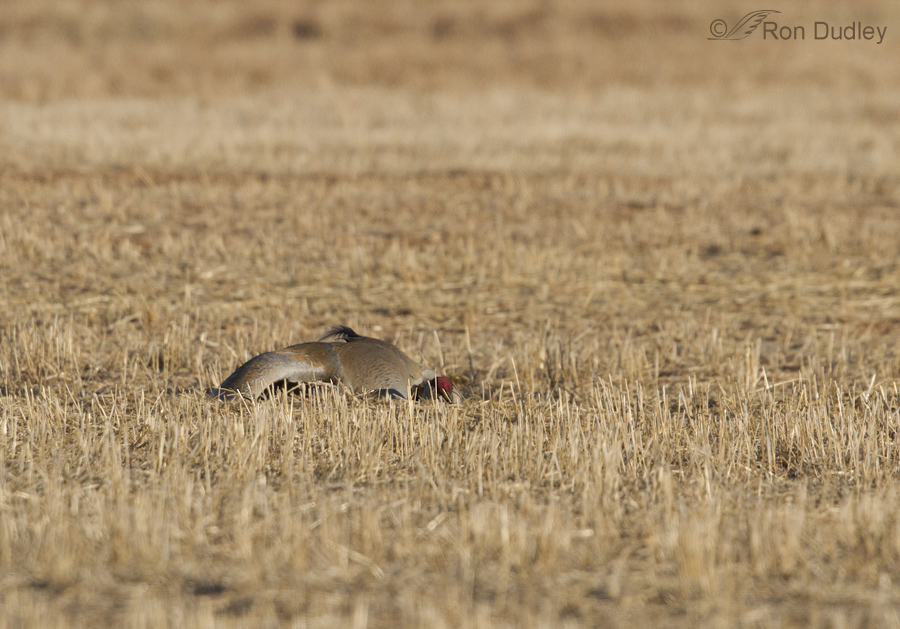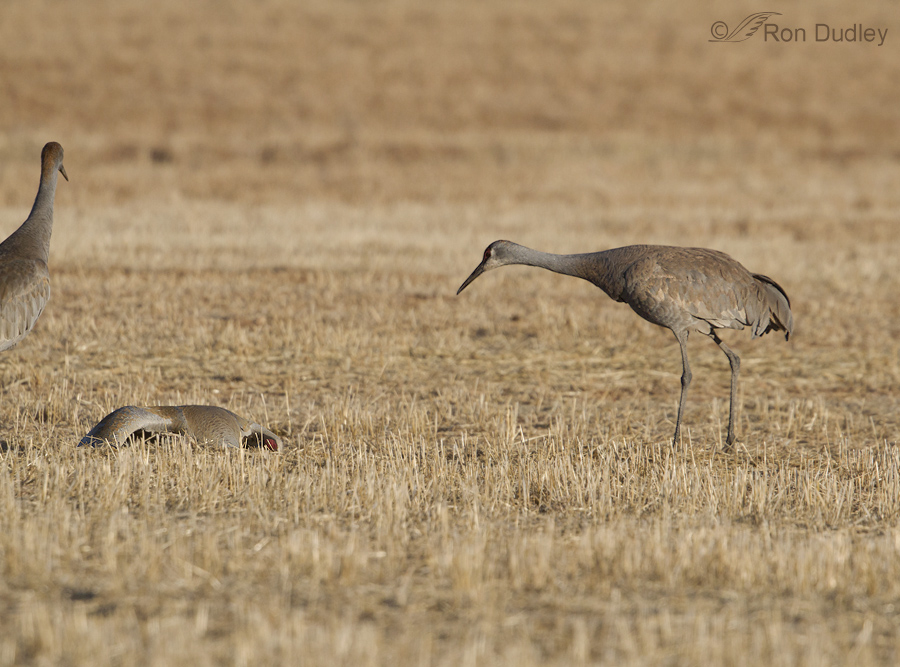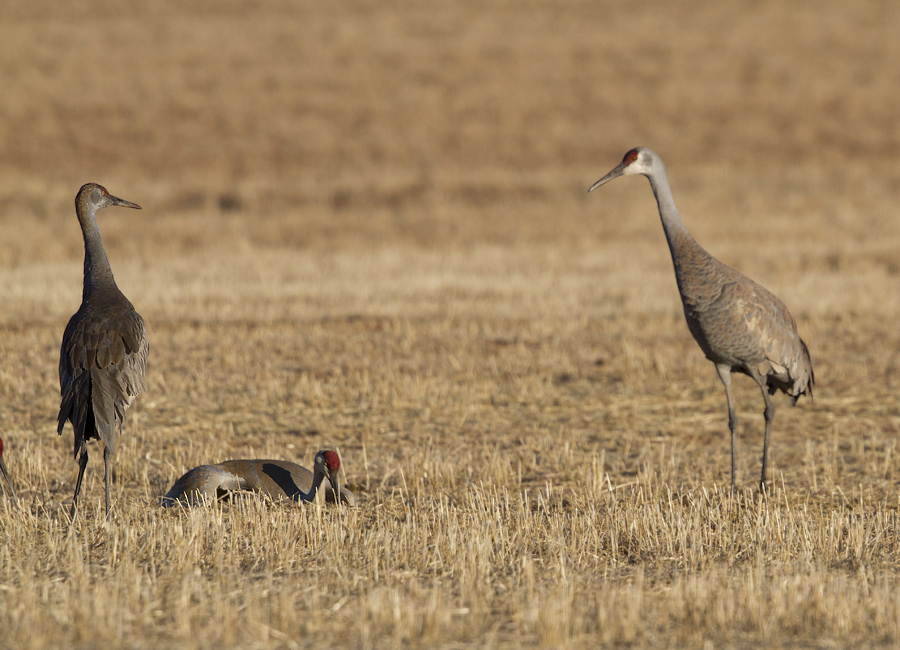Most of the Sandhill Crane behaviors I observed last week were typical for the species but one was quite unusual.
I photographed and observed these migrating cranes in Wayne County for many hours over five days. There were usually between 13 and 33 individual birds present and their activities ranged from docile feeding to frenzied displays of aggression and dancing. Only twice in all that time did I observe a crane lay down on the ground. One bird simply appeared to be resting and soon got back up to resume foraging.
But what was going on with this bird has me stumped. It laid down in what appeared to be a slight depression, spread out at least one of its wings and seemed to press its bill and face close to the ground and it held that posture for some time.
Almost immediately other birds gathered around and one of them in particular seemed intensely curious about what was going on. The bird on the ground held its posture.
But a short time later it raised its head and eventually got up and resumed its feeding, as did the rest of the cranes.
I attempted to research the behavior but even though there’s a plethora of information in the literature about Sandhill Crane behaviors I struck out on this one. I can only guess that it was a social signal of some kind to other birds or perhaps it was pre-nesting behavior. I really have no clue as to its significance.
But I found it fascinating nonetheless.
Ron





You obviously weren’t the only one curious about this behavior…other cranes were, too. Their curiosity makes me wonder even more! I sure hope it’s not something sad and ominous….
That crane on the right was intensely curious, Patty.
I noticed that and it worried me…
Interesting…maybe the start of nesting? Great shots, that last image calls for a caption.
Thank you, Jane.
Back in the day, we’d lay down and put our ear to the ground. Listening for a run-away herd of buffalo … or the cavalry coming over the hill. ;D
Now that’s a novel possibility, Lois. Made me smile!
Maybe thats a teenager bird…a bit lazy and wanting to loll about…then mama comes along and says…get up!
I’ve known some teenagers like that…
???
I looks to me like the poisoning scenario is at least a plausible answer. Sick birds do this – parrots in captivity who have heavy-metal poisoning, and they are prey birds, too… Prey birds have to feel pretty bad to lay down. Sandhill cranes are definitely not predators.
I hope not, Karen…
Fascinating. A number of the birds who visit us adopt ‘dead bird pose’ lying on the grass/dust in the sun. The first few times I saw it I was convinced that there had been a fatality. I would guess that they were warming themselves, sunbathing after your long winter, but hope that you find a definitive answer.
I hope so too, Elephant’s Child. I’ve never seen what you describe as the “dead bird pose”.
I will try and get a photo for you in the next couple of days. It is often, but not exclusively pigeons. And they really do look like ‘past parrots’.
I look forward to it, Elephant’s Child. I used to raise pigeons as a kid and don’t recall ever seeing it.
Hi Ron,
Maybe my biologist-husband, Dan will also chime in, but although we’ve not witnessed cranes doing this, a similar behavior is seen in many other bird species. We ourselves have been able to observe this sun- and warmth-seeking behavior, for lack of a better term, in Chestnut-backed Chickadees, and juncos, and a slightly different behavior but related (anting) in Scrub Jays. Dan just wrote an article soon to be published on the very topic of “things birds do that aren’t immediately obvious as to cause.” The way he puts it, this sun-bathing behavior allows the warmth of the sun’s heat to penetrate below the feathers, possibly down to the skin, and this warmth bothers parasites, so they move to cooler parts of the body to escape. That movement, then gives the bird the opportunity to preen and grab those parasites before they can reattach themselves elsewhere, potentially, at least. Perhaps that’s what is going on here? (But, the looks from the other birds looking on is curious, too…)
Barbara, Yes, Louise Shimmel (below) brought up the possibility that it could be sunbathing and Jonelle Balais mentioned anting as a potential explanation. Either one could be the answer – wish I knew for sure. Thank you for your input.
Wow, exceptional capture Ron. It is great to observe things now and again that leave you stumped and scratching your head. It’s very rewarding, and Keeps you thinking. Very grateful you shared this.
Thanks very much, Bryce.
Possible
In the behavior called anting, birds rub insects on their feathers, usually ants, which secrete liquids containing chemicals such as formic acid, that can act as an insecticide, miticide, fungicide, bactericide, or to make them edible by removing the distasteful acid. It possibly also supplements the bird’s own preen oil. Instead of ants, birds can also use millipedes. Over 250 species of bird have been known to ant.
Jonelle, That’s one possibility we’ve discussed when I linked to this post on Facebook. Could be…
Could this possibly be just the crane wanting to soak up the sun? I know they aren’t the same but chickens (and other birds for that matter) may stretch out their wings and legs to increase the area that the sun hits. Just a guess, but what do I know
Jillian, Louise brought up that possibility below, apparently as you were typing your comment. Could be I guess…
I know nothing about cranes but I do know that many birds love to sunbathe. Even though they may be actively perching or foraging in sunlight, they will purposely lay down on the ground or even on a perch, spread their wings, often cock their head, and look blissed out. I have a photo of our education director lying in the grass with our Swainson’s hawk spread-eagled (as it were!) next to her, both enjoying the rays. When our corrida do it, it’s often on a perch, and they will not only turn their head but open their mouth. NOT their most intelligent look and if you didn’t know what they were doing, you’d think they were in distress. Could the crane be sunbathing?
It’s possible, Louise but it didn’t look like typical sunbathing to me. But what do I know…
Hi, Ron. Haven’t seen sandhill cranes doing this, but when I see trumpeter swans behaving the same way,t it is often lead poisoning. Lead poisoning is the result of eating a lead shotgun pellet or a small piece of lead fishing tackle such as a split-shot or jig. I’ve seen swan families come back to visit their fallen family members. Here in MN, lead poisoning is the ultimate fate of 40% of our trumpeter swans. Hopefully, your sandhill crane behavior is not that.
A disturbing possibility, Bill. Sure hope it’s not the case.
Looks like submissive behavior to me.
Love your work!
Thank you, Leslie.
Ron, we see hundreds of migrating Sandhill Cranes each year and have a fairly significant number of resident cranes who breed here. In all the years I’ve observed them, I haven’t seen behavior like that you’ve pictured. Lots of speculation about what it could mean but no facts, I’m afraid.
Fascinating!
Thanks, Wally – your feedback was valuable because I don’t have a lot of experience with these birds and wasn’t sure how unusual the behavior might be. Very helpful.
Very interesting!
Charlotte
Thank you, Charlotte.
Interesting Ron. I have never seen this kind of SHCR behavior. Your great photo of the curious other crane is really powerful! The other crane not only looks curious, but also concerned. Very interesting.
Thank you, Ed. After all those hours of watching these birds, this behavior really stood out. Wish I know what it meant…
Ron, I am down at the Bosque del Apache NWR refuge today, a major SHCR refuge, so I will ask some of the crane biologists here if I can, and let you know if I find out anything. I liked seeing your photos earlier of the cranes with the Utah sandstone cliffs in the backdrop.
Great! I’d love to find out the significance of this behavior (if it has one). I hope you have a great time at Bosque, Ed. I’ve never been there.
Hi Ron, I asked two of the staff at the Bosque del Apache NWR about this and they had never heard of it or seen it. Crane yoga ?